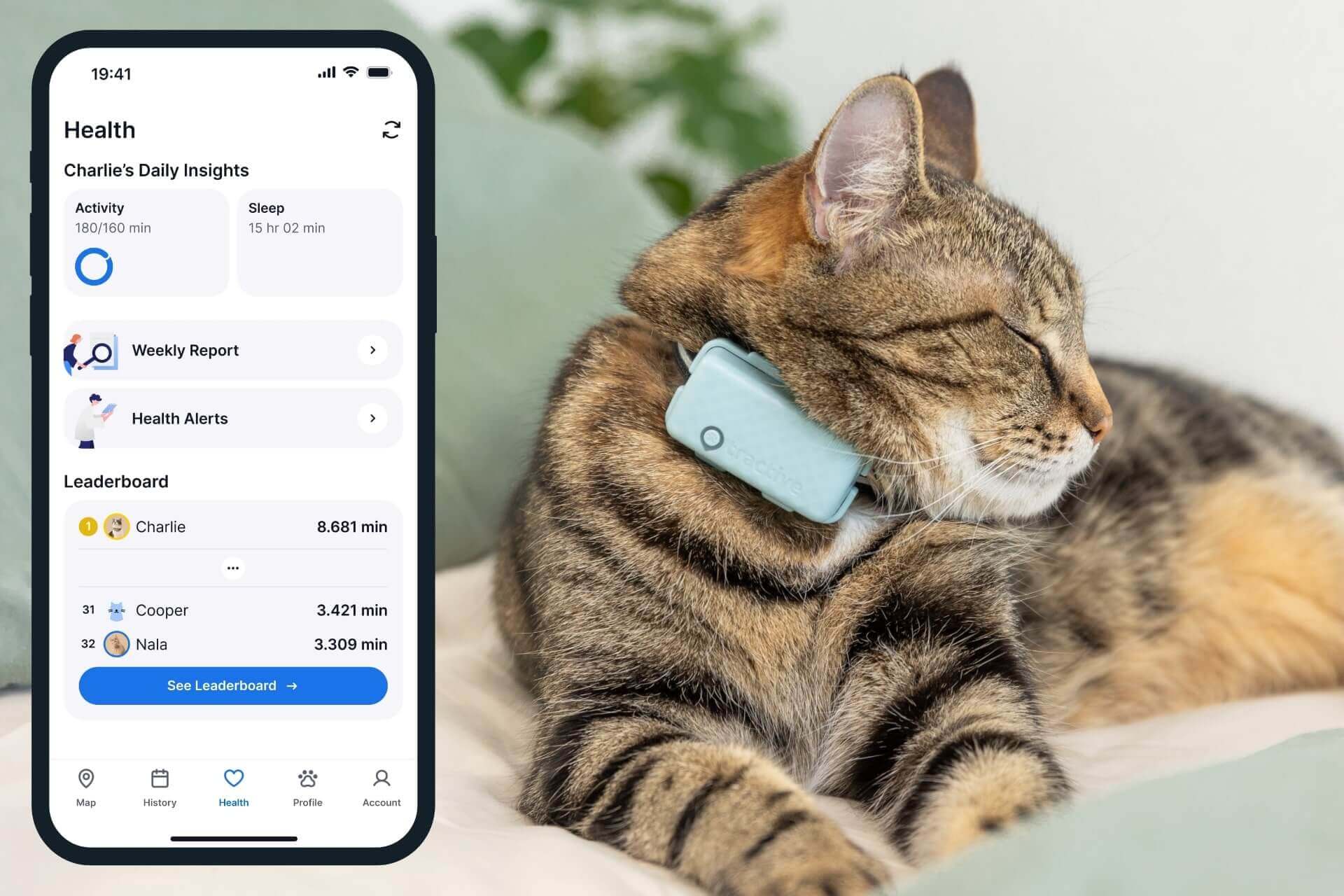Why Is My Cat Shaking? A Comprehensive Guide
While seeing your cat shake can be frightening, it's not always a cause for panic. Here are all the reasons behind it & what you can do.

Our feline friends are masters of hiding discomfort. So when they show a symptom as clear as trembling, it’s natural to immediately wonder, “Why is my cat shaking?” Is it a sign they’re sick or nothing to worry about?
The good news is that shaking isn’t always a sign of something serious. It can be caused by everything from a vivid dream to simple excitement. However, it can also be a signal that something is wrong. Let’s dive into the various reasons why your cat might be shaking, what you can do to help, and where a smart cat collar can help you spot potential health issues early.
Key Takeaways
Shaking isn’t always a sign of something serious. It can be caused by a dream, excitement, or simply being cold.
Head to your vet if the shaking is accompanied by lethargy, vomiting, or other signs of illness.
Your vet will perform an exam and may run tests to find the root cause, which can range from an ear infection to a metabolic disorder.
The Tractive smart cat collar can help you spot changes in your cat’s activity and sleep patterns early on, giving you valuable information to share with your vet.

Find out where your cat spends their time.
Read more- Key Takeaways
- Why is my cat shaking? The less “scary” reasons
- Why does a cat’s body vibrate?
- Do cats shiver when sick?
- Cat shaking head? Why it’s happening
- Should I be worried if my cat is shaking?
- How your vet might diagnose what’s causing your cat to shake
- How is shaking in cats treated?
- How you can help a cat with tremors
- Where a smart cat collar can help
Why is my cat shaking? The less “scary” reasons
Many times, a cat’s tremors are completely normal and nothing to be concerned about. These are often related to a cat’s emotional or physical state. It could be due to:
- Dreaming
If you’ve ever seen your cat twitch, shudder, or even let out a small meow while asleep, you’re likely witnessing them in the middle of a dream. Just like us, cats experience REM sleep, and their muscles can twitch as they act out their dreams. This is especially common in kittens. - Excitement
You may notice your cat’s body vibrating or trembling when they’re staring intently at a bird outside the window or when you’re preparing their favorite treat. This is often an expression of intense focus and excitement, and it’s a completely normal behavior. Their body is simply getting ready to pounce! - The cold
A cat can shiver when they’re cold, just like a human. This is their body’s way of generating heat. If your cat is shivering after being in a chilly area, try giving them a warm blanket or a cozy spot in the sun.
Read More: How Cold Is Too Cold For Cats?
Why does a cat’s body vibrate?
This behavior is often linked to a cat’s most famous behavior: purring. A cat’s body vibrates when they purr, and sometimes this purr is so deep and powerful that it feels more like a full-body rumble than a gentle vibration. While purring is often a sign of contentment, cats also purr to self-soothe when they are in pain or distressed. So if you feel a strong vibration, check for other clues about your cat’s mood.
Do cats shiver when sick?
Yes, they absolutely can. Shivering is a very common physical response to illness, and it’s a way for the body to generate heat when it’s fighting an infection. If your cat is shaking and also seems lethargic, isn’t eating, or is hiding, it’s a strong sign they might be feeling under the weather.
Read More:
- Lethargy In Cats: Why It Happens & How To Handle It
- Cat Not Eating As Much? These Might Be The Reasons Why
- Why Is My Cat Hiding? 5 Reasons Why & How To Find Them
- 10 Signs Of Illness In Cats
Cat shaking head? Why it’s happening
A shaking head is often a specific symptom pointing to an issue with your cat’s ears or head. It could be due to:
- Ear mites or infections
Ear problems are a very common reason for head shaking. Mites or an infection can cause intense itching and discomfort, leading your cat to shake their head vigorously to try and get rid of the irritation. - Foreign objects
A small piece of debris or even a bug could get stuck in their ear canal, causing them to shake their head to dislodge it. - Polyps or growths
In some cases, a head tremor can be caused by a growth in the ear canal or surrounding area.

Should I be worried if my cat is shaking?
While many causes are harmless, take note if the shaking is accompanied by other symptoms or seems severe. It’s always best to err on the side of caution and contact your veterinarian if you notice any of the following:
- The shaking is new or sudden.
- The tremors are severe or seem uncontrolled.
- The shaking is accompanied by other symptoms like lethargy, vomiting, diarrhea, loss of appetite, or difficulty breathing.
- Your cat seems disoriented, confused, or has a blank stare.
- The shaking seems to be a seizure (uncontrolled muscle spasms, possibly with drooling or loss of consciousness).
These could be signs of serious health issues like:
- Pain
From arthritis, internal injuries, or other sources of chronic pain. - Toxicity
Ingesting a poisonous plant, household chemical, or human medication. - Neurological issues
This can range from a simple ear issue to more serious conditions like seizures, brain inflammation, or a head injury. - Metabolic disorders
Low blood sugar (hypoglycemia) is a common cause of tremors, especially in diabetic cats.
How your vet might diagnose what’s causing your cat to shake
When you take your cat to the veterinarian for shaking or tremors, they’ll likely start with a thorough physical exam and ask you a series of questions. It can be incredibly helpful to bring a video of the shaking episode if you have one, as it can provide your vet with valuable clues. Go prepared to answer
- When the shaking started
Was it sudden or has it been happening for a while? - What other symptoms your cat has
Is the shaking the only symptom, or are they also lethargic, vomiting, or not eating? - Your cat’s recent history
Have they had any potential exposure to toxins or suffered any recent trauma? - Your cat’s diet and any medications they take
Based on the physical exam and your answers, your vet may recommend diagnostic tests to pinpoint the cause, such as:
- Blood and urine tests
To check for metabolic disorders, organ function (like the liver and kidneys), and potential toxicity. - X-rays
To check for injuries or pain. - Neurological exam
To assess your cat’s nervous system.
How is shaking in cats treated?
The treatment for your cat’s shaking will depend on what the underlying cause is. After your vet has completed their diagnosis, they will be able to recommend a treatment plan that directly addresses the root of the problem. Here are a few examples of how different causes of shaking might be treated:
| Possible cause | Possible treatment |
|---|---|
| Ear infections | Medicated ear drops to treat the infection and clear out any mites. |
| Pain | Prescription pain medication, anti-inflammatory drugs, physical therapy, or nutritional supplements. |
| Hypoglycemia | Management of diet and insulin levels, especially for diabetic cats, to prevent blood sugar from dropping. |
| Toxicity | Immediate medical intervention to stabilize the cat and remove the toxins from their system, which may include induced vomiting, activated charcoal, or intravenous fluids. |
| Anxiety | Behavioral changes to reduce stressors, calming aids, or, in more severe cases, anti-anxiety medication. |
How you can help a cat with tremors
First, try to pay attention to when and how the shaking occurs. Is it while they are sleeping? Or is it when they are cold? Is it a quick, brief twitch or a long, sustained tremor?
For some cats, adjusting the home environment can be a great help. You can create a safer space to prevent falls or injury by:
- Slip-proofing your home
If your cat’s tremors affect their balance, non-slip rugs or mats on hard floors can provide better traction. Using sturdy food and water bowls can also prevent slipping. A litter box with low entry and high sides can make it easier for them to enter and lean on while doing their business. - Prevent your cat from falling
By blocking off stairways or high-up furniture and placing cushions around high surfaces. (In case your cat does take a tumble.) - Enriching their environment
For cats with chronic tremors, an enriched indoor environment is often the best option. This helps to prevent boredom and stress while keeping them safe from predators and other outdoor dangers. Think of things like cat trees, puzzle feeders, and plenty of toys to engage their mind and body.
Where a smart cat collar can help
For cat parents who want a more proactive way to monitor their cat’s health, a smart collar with Health Monitoring can be a game-changer. Products like the Tractive smart cat collar use built-in motion sensors to provide insights from Activity Tracking and Sleep Tracking.

Strapped to your cat’s collar, here’s how it can help with tremors:
- Spotting changes
You might not notice that your cat is sleeping more, or that their active periods are becoming shorter. A health monitoring device can show you a clear, long-term record of these patterns. - Health Alerts
If your tracker detects a sudden change in their activity or sleep, you’ll get a Health Alert, prompting you to investigate further or consult your vet. - Monitoring your cat’s outdoor wanderings
If you do let your cat outside, your tracker includes real-time GPS tracking to help you keep tabs on their whereabouts – no matter how far. Just switch to LIVE tracking and watch their real-time location updated every few seconds. Besides, unlike an AirTag, Tractive devices don’t need a network of compatible devices to work. They also work across an unlimited range.
This data can help you spot a potential issue early and give your vet the information they need to help your furry friend.

Get health alerts for your cat
Our cats can’t always tell us if something’s wrong. But if their tracker detects unusual changes in their routine, you’ll get an alert, helping you catch potential issues early.
Wrapping up: While seeing your cat shake can be frightening, it’s not always a cause for panic. Keep an eye out for when and how it occurs and get in touch with your vet if they don’t seem themselves. This way, you’ll be well-equipped to know when it’s time to drop over for a checkup.
And if you’ve liked this post, share it with a friend or a loved one – and let’s help build a safer, kinder world for our furry friends together.



